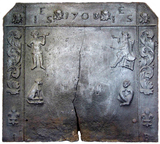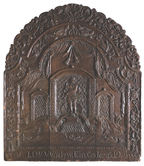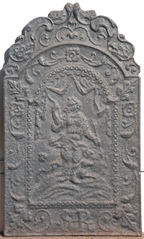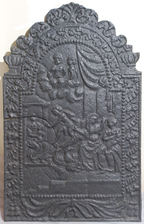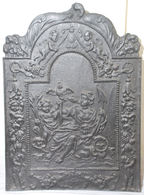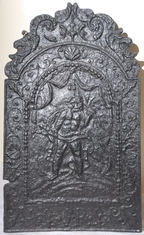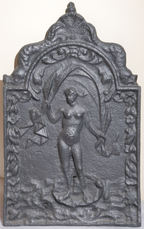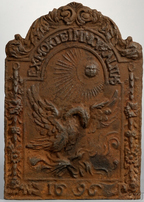-
890
Description: Canted rectangle; cavetto moulded edging (top and sides); single horizontal fillet below canted corners and vertical fillet parallel to each side, dividing the fireback into two side panels, two top corner panels, top panel and main central panel; corner panels, ‘daisy’ plant stamp; top panel, date between ‘daisy’ stamps, between initials in triad at each end; side panels, swirling foliage stamp repeated each side above a fleur-de-lys, above initial 'I' on left and 'B' on right; centre panel, stamp of ‘Indian’ smoking a pipe at top left, stamp of seated ‘gentleman’ smoking a pipe and holding another, at top right; below each, a seated monkey stamp, that on the left seated facing right, its paws in front of it and its tail below, that on the right seated facing left, its tail drawn across its chest.
Notes: The IB initials are identical to those on similar firebacks dated between 1703 and 1721, probably indicating the same founder. The number 3 of the date and the fleur-de-lys on the lower left side have been over-pressed showing the backs of the stamps. The use of stamps relating to tobacco smoking may suggest an origin near Bristol, the main entry port for the tobacco trade at that time.
Inscription: IES [triad] 1703 IES [triad] / I B
- Decoration tags:
- rectangular with canted top corners (shape)
- fillet (edging)
- carved stamps
- heraldic
- text
- animals
- humans
- plants
Manufactured: in 1703 in the Forest of Dean area of England.
Current location: Greys Court, Rotherfield Greys, Oxfordshire, England.
Museum number: 196857 (part of the National Trust museum group)
- Attached to series:
- IB series
- Date & initials firebacks
-
931
Description: Carved wooden fireback pattern. Arched rectangular shaped central panel with top corners cavetto canted, bead-and-pellet edging on a wide fillet; hanging drapery with central tassels over three low-arched cubicles, the two outer smaller than the centre, with Tuscan columns and overlapping scales behind; on a plinth of overlapping scales with a scallop shell behind, the standing figure of Neptune/Poseidon, holding a trident in his right hand; water issues from by his feet and from the waves below him disport two 'sea horses' and three dolphins; arched rectangular shaped border with top corners cavetto canted, fillet edging: suspended symmetrical beads with tassel ends decorated with sea shells; at the bottom, between looped 'W' figures, the inscription separating halves of the date along the bottom; above, a central scallop shell with symmetrical floral scrolls on each side. Two vertical planklines left and right of centre.
Notes: Carved on three vertical oak planks, battened together, from a design in 'Nouveaux livres de ...Statues [etc.]' (La Haye & Amsterdam 1702-5), by Daniel Marot. The inscription, translated from the Welsh as 'GOD is our strength', is a paraphrase of Psalm 46: 1; an identical inscription and date is found on several firebacks. All incorporate the looped 'W' motif which may be intended to identify the pattern maker. A casting made from this pattern is no. 271.
Inscription: 17 DVW Ydyw Ein Cadernid 24
- Decoration tags:
- 'Dutch' (shape)
- fillet (edging)
- whole carved pattern
- planklines
- pictorial
- mythological
- architectural
- text
- animals
- humans
- objects
Manufactured: in 1724 in England.
Current location: Rotterdam, Netherlands.
Museum number: 35437 (part of the Museum Rotterdam museum group)
- Attached to series:
- 1724 series
- Welsh inscription series
- Patterns
-
671
Description: Arched rectangular central panel with hollow bead edging on a broad fillet; figure of a woman standing on a mound, holding a bow in her right hand and an arrow in her left, a plant to her right, and drapery swags above; arched rectangular border with symmetrical swirls of foliage and diagonal leaves at corners; monogram centre bottom between swirled tendrils; on top, symmetrical, swirled foliage.
Notes: The figure is of Diana, goddess of the Moon and of hunting; she carries a bow and arrow, and has a hound at her feet. The depiction is derived from 'Statues of Roman Gods', a set of engravings dated 1585, by Philips Galle after Jacques Jonghelinck.
Copies of this fireback are known.
Inscription: SHR
- Decoration tags:
- 'Dutch' (shape)
- fillet (edging)
- whole carved pattern
- pictorial
- mythological
- monogram
- text
Manufactured: in the late-17th to early-18th century in England.
Current location: Rottingdean Grange, The Green, Rottingdean, East Sussex, England.
Museum number: RGTMP000082 (part of the Brighton Museum museum group)
Citation: Elling, W. & Winkler-Borck, S., 1992, Ofen- und Kaminplatten (Vreden, Hamaland-Museum).
- Attached to series:
- SHR series
- British 'Dutch' style firebacks
-
673
Description: Arched rectangular central panel and bead edging; pictorial scene probably showing the annunciation of the Virgin Mary; Mary sits beneath a canopy on the left, to which an angel descends, behind two figures seated on a stepped dais; above, two figures sit above a cloud, a curtain to the right; arched rectangular border with fillet edging, containing twisted ribbon; palm fronds gathered with a ribbon along the bottom. On top, two vases, one on each shoulder of the border, with swirled foliage descending from a central scallop shell.
Notes: The scene appears to be from the New Testament, probably relating to the Annunciation or the Nativity.
Manufactured: in the late-17th century possibly in the Siegerland area of Germany.
Current location: Saffron Walden Museum, Saffron Walden, Essex, England.
Museum number: 2819 (part of the Saffron Walden Museum museum group)
- Attached to series:
- 'Dutch' Miscellaneous Firebacks
- New Testament firebacks
-
674
Description: Arched rectangular shaped central panel with bead edging; pictorial scene of a seated female figure resting against a hurdle, holding an anchor, a child on each side of her, the one on the left standing clutching corn stalks, the one on the right sitting also holding the anchor and a circular object; a bird sits on a post; arched rectangular border with fillet edging; at the top of the arch a cartouche from which are suspended two ribbons, each held by a putto, from which cascade flowers and fruit, each lower part hung from a ring; two putti are on each side, one climbing on the suspended ribbon, the other at its foot; at the bottom, an empty cartouche between two clusters of flowers each suspended on a ribbon tied to a scroll; on top, two descending cornucopiae.
Notes: The figure represents Hope. The theft in 1699 from a Thames-side warehouse of several firebacks, including '3 of Hope with an Anchor' may refer to this type (Post Boy 11-14 Nov. 1699).
Copies of this fireback are known.
- Decoration tags:
- 'Dutch' (shape)
- fillet (edging)
- whole carved pattern
- pictorial
- allegorical
- humans
- objects
Manufactured: in the mid- to late-17th century in the Siegerland area of Germany.
Current location: Saffron Walden Museum, Saffron Walden, Essex, England.
Museum number: 1889-9 (part of the Saffron Walden Museum museum group)
- Attached to series:
- 'Dutch' HIS series
- Hope firebacks
-
676
Description: Arched rectangular central panel; bead-and-pellet edging; scene showing a semi-naked figure holding a trident in his right hand and a sheaf of corn in his raised left hand; standing on ground, with swagged drapery and tassels above, and an anchor behind right; arched rectangular border with fillet edging; on top, scallop shell symmetrical descending arrangement of swirled fronds and shells, which continue on the bottom; monogram at bottom centre; on top, mirrored stylised sea monsters.
Notes: The figure is Neptune, one of a set of 'Eight Deities' engraved by Hendrick Goltzius (1592), after Polidoro da Caravaggio; the fireback is one of a large group bearing the same initials, which probably denotes the pattern maker. Other groups may have been the work of the same carver or workshop. The execution is rather crude.
Copies of this fireback are known.
Inscription: SHR
- Decoration tags:
- 'Dutch' (shape)
- fillet (edging)
- whole carved pattern
- pictorial
- mythological
- monogram
- text
- humans
Manufactured: in the late-17th to early-18th century in England.
Current location: Saffron Walden Museum, Saffron Walden, Essex, England.
Museum number: 1889-35 (part of the Saffron Walden Museum museum group)
- Attached to series:
- SHR series
- British 'Dutch' style firebacks
- Eight Deities series
-
678
Description: Arched rectangular main panel; fillet edging; nude female figure standing on shield and holding a wind-blown sheet, upon a ground; suspended floral garlands with swirled foliage above; on top, a scallop shell between two symmetrical sea serpents
Notes: The figure is of Fortune. The theft in 1699 from a Thames-side warehouse of several firebacks, including '5 iron Chimney-Backs cast in the figure of Fortune standing naked on a Conchus in the Sea' may refer to this type (Post Boy 11-14 Nov. 1699).
- Decoration tags:
- 'Dutch' (shape)
- fillet (edging)
- whole carved pattern
- pictorial
- allegorical
- humans
Manufactured: in the mid- to late-17th century possibly in the Siegerland area of Germany.
Current location: Saffron Walden Museum, Saffron Walden, Essex, England.
Museum number: 1901-39 (part of the Saffron Walden Museum museum group)
- Attached to series:
- 'Dutch' Miscellaneous Firebacks
-
1173
Description: Arched rectangular central panel with bead on broad fillet edging; pictorial scene of Neptune/Poseidon, a trident in hand, in a chariot drawn through the waves by two 'sea horses', above are clouds and three birds; arched rectangular border with fillet edging; diagonal grid forming squares, in each one of two types of flower arranged in alternate lines; at the bottom, the letter W in a cartouche between swirled foliage; on top, mirrored swirled foliage issuing upwards from a mythical creature on each shoulder.
Notes: There is some question as to whether this is a later pastiche of an early-eighteenth century style,
Inscription: W
- Decoration tags:
- 'Dutch' (shape)
- fillet (edging)
- whole carved pattern
- pictorial
- mythological
- text
- humans
- objects
Manufactured: in the late-17th to early-18th century in England.
Current location: Macintosh Antiques, The Courtyard, Newland, Sherborne, Dorset, England.
- Attached to series:
- W series
- British 'Dutch' style firebacks
-
998
 pl 66 brede place a.jpg) ? x ? mm
? x ? mmDescription: Arched rectangular shape; fillet edging with a wider fillet within upon which are regularly-spaced beads each set on disc and joined by a thin line; shield, Garter, helm, mantling, crown and lion crest, with crowned lion and unicorn supporters; metal strapping around main rectangle.
Notes: A damaged example with unusual supporting bands. Formerly at Brede Place, East Sussex.
Inscription: HONI SOIT QVI MAL Y PENSE
Arms: English Stuart royal
- Decoration tags:
- rectangular with round arch (shape)
- fillet (edging)
- whole carved pattern
- armorial
- royal
- text
Manufactured: in the early- to mid-17th century possibly in the Weald area of England.
Current location: not known.
Citation: Shuffrey, L. A., 1912, The English Fireplace, London, Batsford.
- Attached to series:
- Stuart royal armorial firebacks
-
1082
Description: Arched rectangular central panel; fillet edging; pictorial scene of a phoenix rising from a fire; above right, a human mask at the centre of a sunburst; arched rectangular border with fillet edging, the date between initials along the bottom; down each side, a floral festoon hanging from a ring; over the arch, the inscription; on top, floral scrolls.
Notes: The inscription translates as 'out of death, immortality'; the initials NL are likely to be those of the pattern maker. Skinner's, Marlborough, Massachusetts, auction 14 Aug 2016 lot 226.
Inscription: EX MORTE IMMORTALITAS / N 1696 L
- Decoration tags:
- 'Dutch' (shape)
- fillet (edging)
- carved pattern panels
- pictorial
- mythological
- text
- animals
Manufactured: in 1696 possibly in the Siegerland area of Germany.
Current location: not known.
- Attached to series:
- 'Dutch' 1696 NL series
- Phoenix firebacks
